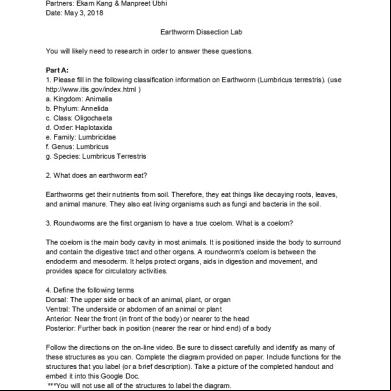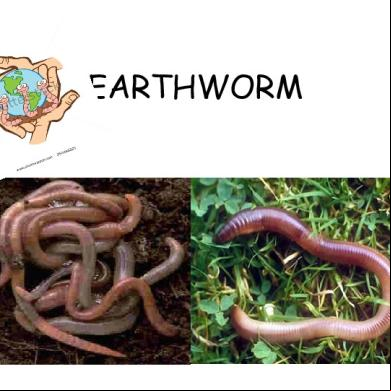Earthworm Dissection - Jasmin Lidder 1 2q4j30
This document was ed by and they confirmed that they have the permission to share it. If you are author or own the copyright of this book, please report to us by using this report form. Report 3i3n4
Overview 26281t
& View Earthworm Dissection - Jasmin Lidder 1 as PDF for free.
More details 6y5l6z
- Words: 905
- Pages: 5
Name: Jasmin Lidder Partners: Ekam Kang & Manpreet Ubhi Date: May 3, 2018 Earthworm Dissection Lab You will likely need to research in order to answer these questions. Part A: 1. Please fill in the following classification information on Earthworm (Lumbricus terrestris). (use http://www.itis.gov/index.html ) a. Kingdom: Animalia b. Phylum: Annelida c. Class: Oligochaeta d. Order: Haplotaxida e. Family: Lumbricidae f. Genus: Lumbricus g. Species: Lumbricus Terrestris 2. What does an earthworm eat? Earthworms get their nutrients from soil. Therefore, they eat things like decaying roots, leaves, and animal manure. They also eat living organisms such as fungi and bacteria in the soil. 3. Roundworms are the first organism to have a true coelom. What is a coelom? The coelom is the main body cavity in most animals. It is positioned inside the body to surround and contain the digestive tract and other organs. A roundworm’s coelom is between the endoderm and mesoderm. It helps protect organs, aids in digestion and movement, and provides space for circulatory activities. 4. Define the following Dorsal: The upper side or back of an animal, plant, or organ Ventral: The underside or abdomen of an animal or plant Anterior: Near the front (in front of the body) or nearer to the head Posterior: Further back in position (nearer the rear or hind end) of a body Follow the directions on the on-line video. Be sure to dissect carefully and identify as many of these structures as you can. Complete the diagram provided on paper. Include functions for the structures that you label (or a brief description). Take a picture of the completed handout and embed it into this Google Doc. ***You will not use all of the structures to label the diagram.
EARTHWORM ANATOMY:
COMPLETED DISSECTION:
Part B: 1. Describe two ways in which an earthworm’s body is adapted to life in the soil. An earthworm’s body is in a stream-like shape, which allows it to bury itself in soil. As well, it has no skeleton or rigid structure interfering with their movement in the soil. 2. Explain how an earthworm demonstrates cephalization. Cephalization is the concentration of nerve cells at one end of the body. An earthworm has a small, simple brain that is located at the anterior end of the body. 3. Although they are related, the digestive system of an earth worm and Ascaris are very different. Why do you think this is? Ascaris relies on digested food from its host so it doesn’t need to digest its own food. On the other hand, earthworms feed on tough foods like decaying plants and animals, so its digestive system must be capable of digesting these foods.
4. Compare the reproductive system of the earthworm with that of Ascaris. Be sure to note both similarities and differences. One difference is that earthworms are hermaphroditic, meaning they carry both male and female reproductive organs, whereas in Ascaris, the sexes are separate. However, they both have similar reproductive organs, such as the seminal vesicle and testis. 5. What are some ways that annelids are beneficial? Annelids are beneficial because they enrich soil, create new topsoil, and provide food for small animals. 6. What features distinguish annelids from roundworms? Annelids are segmented, but roundworms are not. Annelids also have a more complex nervous system and circulatory system than roundworms. 7. Why are many species of earthworms considered Invasive Species in North America? Many species of earthworms are considered Invasive Species because out of about 6,000 species, about 120 of them are distributed around the world. In North America where forest ecosystems rely on large amounts of undecayed leaves, worms decompose the leaf layer, making it more difficult for certain trees and plants to survive there. 8. What impact are earthworms having on natural ecosystems (especially in forests)? The forests in which earthworms invade is drastically affected by the absence of a leaf-litter layer on the ground (because worms eat decaying plants and leaves) as it reduces the amount of seedlings and flowers. They also change the physical and chemical properties of soil, affecting many native species. 8. What steps can you take to prevent earthworms from spreading? To prevent earthworms from spreading, be careful to avoid moving them when moving soil or plants. Also, make sure to clean your shoes/boots if they’re in with soil, as soil can carry lots of worm eggs. As well, you should dispose worm bait in areas of known worm infestation, instead of dumping the bait on land in natural areas like forests. Conclusion: We were able to dissect a worm and locate a variety of parts, such as the crop, pharynx, and dorsal blood vessel. Unfortunately when we started, we cut too deep into the worm, revealing a lot of soil. However, we quickly recognized our mistake and cut much more gently as we cut all the way down to the anus. This left us with a more clean cut and it was easier to see everything,
instead of the soil when we first started cutting. We learned that earthworms have both positive and negative impacts on the ecosystem. They move soil around to expose more nutrients, but they also affect the forest as they change the chemical and physical properties of the soil. Because of this, it is important not to spread earthworms around natural areas, such as forests, where animals and plants can be dramatically affected by the changes earthworms cause.
EARTHWORM ANATOMY:
COMPLETED DISSECTION:
Part B: 1. Describe two ways in which an earthworm’s body is adapted to life in the soil. An earthworm’s body is in a stream-like shape, which allows it to bury itself in soil. As well, it has no skeleton or rigid structure interfering with their movement in the soil. 2. Explain how an earthworm demonstrates cephalization. Cephalization is the concentration of nerve cells at one end of the body. An earthworm has a small, simple brain that is located at the anterior end of the body. 3. Although they are related, the digestive system of an earth worm and Ascaris are very different. Why do you think this is? Ascaris relies on digested food from its host so it doesn’t need to digest its own food. On the other hand, earthworms feed on tough foods like decaying plants and animals, so its digestive system must be capable of digesting these foods.
4. Compare the reproductive system of the earthworm with that of Ascaris. Be sure to note both similarities and differences. One difference is that earthworms are hermaphroditic, meaning they carry both male and female reproductive organs, whereas in Ascaris, the sexes are separate. However, they both have similar reproductive organs, such as the seminal vesicle and testis. 5. What are some ways that annelids are beneficial? Annelids are beneficial because they enrich soil, create new topsoil, and provide food for small animals. 6. What features distinguish annelids from roundworms? Annelids are segmented, but roundworms are not. Annelids also have a more complex nervous system and circulatory system than roundworms. 7. Why are many species of earthworms considered Invasive Species in North America? Many species of earthworms are considered Invasive Species because out of about 6,000 species, about 120 of them are distributed around the world. In North America where forest ecosystems rely on large amounts of undecayed leaves, worms decompose the leaf layer, making it more difficult for certain trees and plants to survive there. 8. What impact are earthworms having on natural ecosystems (especially in forests)? The forests in which earthworms invade is drastically affected by the absence of a leaf-litter layer on the ground (because worms eat decaying plants and leaves) as it reduces the amount of seedlings and flowers. They also change the physical and chemical properties of soil, affecting many native species. 8. What steps can you take to prevent earthworms from spreading? To prevent earthworms from spreading, be careful to avoid moving them when moving soil or plants. Also, make sure to clean your shoes/boots if they’re in with soil, as soil can carry lots of worm eggs. As well, you should dispose worm bait in areas of known worm infestation, instead of dumping the bait on land in natural areas like forests. Conclusion: We were able to dissect a worm and locate a variety of parts, such as the crop, pharynx, and dorsal blood vessel. Unfortunately when we started, we cut too deep into the worm, revealing a lot of soil. However, we quickly recognized our mistake and cut much more gently as we cut all the way down to the anus. This left us with a more clean cut and it was easier to see everything,
instead of the soil when we first started cutting. We learned that earthworms have both positive and negative impacts on the ecosystem. They move soil around to expose more nutrients, but they also affect the forest as they change the chemical and physical properties of the soil. Because of this, it is important not to spread earthworms around natural areas, such as forests, where animals and plants can be dramatically affected by the changes earthworms cause.





